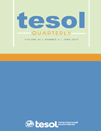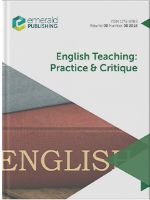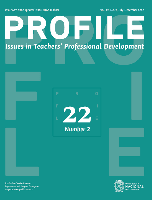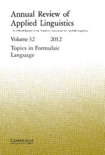
TESOL QUARTERLY
Scope & Guideline
Pioneering Research in Teaching English to Speakers of Other Languages
Introduction
Aims and Scopes
- Multilingual and Translingual Pedagogy:
Explores teaching strategies that incorporate the linguistic and cultural backgrounds of learners, emphasizing the importance of translingual practices in diverse educational settings. - Digital and Technological Integration in Language Learning:
Focuses on the impact of digital tools and technologies on English language teaching, including the use of AI, digital storytelling, and online learning platforms. - Critical Pedagogy and Social Justice:
Investigates the intersections of language education with issues of equity, race, gender, and identity, promoting inclusive practices that address systemic inequalities in language learning. - Teacher Identity and Professional Development:
Examines the evolving identities of language teachers, including their emotional experiences, reflective practices, and the challenges they face in diverse educational contexts. - Assessment and Language Proficiency:
Analyzes various assessment practices and their implications for learners' language development, focusing on formative and summative assessments that support multilingual learners. - Sociocultural Perspectives on Language Learning:
Utilizes sociocultural theories to understand how learners interact with language in their social contexts, emphasizing the role of community and collaboration in language acquisition.
Trending and Emerging
- Emotional Labor and Teacher Well-Being:
Research increasingly focuses on the emotional experiences of language teachers, exploring how emotional labor impacts their professional identities and overall well-being. - Global Englishes and Decolonization:
There is a growing emphasis on understanding the implications of global Englishes and decolonizing English language teaching practices to better serve diverse learner populations. - Equity and Inclusion in Language Education:
Emerging studies address issues of equity and inclusion, with a strong focus on the experiences of marginalized groups and the necessity for culturally responsive pedagogies. - AI and Technology in Language Learning:
The integration of artificial intelligence and digital tools in language education is a rapidly expanding area, examining both the pedagogical implications and ethical considerations of technology use. - Collaborative and Community-Based Learning:
Research is trending towards collaborative learning experiences that engage students in community contexts, promoting authentic language use and social connections. - Translingual Practices and Multilingualism:
An increasing number of studies are exploring translingual practices, emphasizing how multilingual learners navigate their languages in various contexts and the pedagogical strategies that support this.
Declining or Waning
- Traditional Language Teaching Methods:
There has been a noticeable decrease in research centered on conventional grammar-focused teaching methods, as the field increasingly values communicative and contextual approaches. - Native Speaker Norms and Standards:
Research that prioritizes native speaker models of language proficiency is less prevalent, reflecting a growing acceptance of diverse Englishes and the need for inclusive practices. - Standardized Testing Practices:
The focus on traditional standardized testing methods is declining, as educators and researchers explore more holistic and formative assessment strategies that cater to diverse learner needs. - Monolingualism in Language Education:
Interest in monolingual teaching contexts is waning, with a shift towards embracing bilingualism and multilingualism as central to effective language pedagogy.
Similar Journals

MODERN LANGUAGE JOURNAL
Elevating Scholarly Discourse in Linguistics and Language StudiesThe MODERN LANGUAGE JOURNAL, published by WILEY, stands as a premier academic resource in the field of linguistics and language studies. With its strong legacy dating back to 1916, this journal has evolved to address contemporary issues and trends in language learning, teaching, and research. It holds a prestigious Q1 ranking in both Linguistics and Language categories as of 2023, reflecting its high impact and relevance in scholarly discourse, supported by notable Scopus rankings that place it in the top percentiles of its field. The journal serves as an essential conduit for researchers, educators, and students seeking to contribute to and stay abreast of advancements in language education and linguistic theory. Although it does not currently offer open access options, the journal remains committed to disseminating significant findings that inspire innovative methodologies within the realm of modern languages.

Journal of Asia TEFL
Transforming Educational Landscapes with Research-Driven InsightsWelcome to the Journal of Asia TEFL, a leading peer-reviewed platform dedicated to exploring the intersections of English language education, linguistics, and the dynamic educational landscapes of Asian contexts. Published by ASIA TEFL in South Korea, this journal has emerged as a pivotal resource for academia since its inception in 2004, with consistently expanding influence reflected in its Scopus rankings, including a notable 76th percentile in Linguistics and Language. With a focus on the evolving methodologies and pedagogical innovations in English language teaching, the journal aims to foster scholarly discussions that enhance teaching practices and policy-making in a globalized world. Although it currently operates without open access, its rigor and relevance in categories such as Education and Linguistics ensure that it remains a valuable asset for researchers, educators, and students seeking to advance their knowledge and practice within this vital field of study.

English Teaching-Practice and Critique
Navigating the Landscape of English Teaching with Critical PerspectivesEnglish Teaching-Practice and Critique is an esteemed journal published by Emerald Group Publishing Ltd, focusing on the interdisciplinary fields of Education and Linguistics. With a commitment to advancing knowledge and practice in English language teaching, the journal offers a platform for innovative research, critical reflections, and practical insights that are vital for educators, researchers, and students alike. The journal has established itself in the academic community, achieving a Q3 ranking in Education and a prestigious Q1 ranking in Linguistics and Language as of 2023, highlighting its impact and relevance. Although not an open-access journal, its curated content remains accessible to a global audience, facilitating meaningful discourse and development in English language education. The journal spans articles from 2008 to 2014 and 2016 to 2024, making it a valuable resource for ongoing scholarly dialogue and pedagogical advancement. It is particularly recognized within Scopus rankings, standing at the 76th percentile in Arts and Humanities as well as the 74th percentile in Social Sciences, underscoring its significance and standing in these domains.

Profile-Issues in Teachers Professional Development
Fostering Excellence: Bridging Research and Teacher DevelopmentProfile - Issues in Teachers Professional Development is a distinguished open access journal published by the Universidad Nacional de Colombia, Facultad Ciencias Humanas, aimed at fostering research and discourse surrounding critical issues in educators' ongoing professional development. Since its inception in 2005, the journal has established itself as a significant resource within the fields of Education and Linguistics and Language, reflecting its relevance through its category quartiles, being positioned in Q3 in Education and an impressive Q1 in Linguistics and Language for 2023. The journal boasts a commendable Scopus ranking, reflecting its impact and commitment to advancing scholarly discussion, with rankings of #236 out of 1167 in Linguistics and Language, and #818 out of 1543 in Education. With a converged timeline from 2018 to 2024, it serves as a vital platform for educators, researchers, and students alike, encouraging the dissemination of innovative practices and insights essential for the evolution of teacher training and professional growth in a rapidly changing educational landscape.

Annual Review of Applied Linguistics
Elevating scholarship in applied linguistics.The Annual Review of Applied Linguistics, published by Cambridge University Press, stands as a premier journal in the realm of linguistics and psychology, with an impressive impact factor identifying its significance: ranking in the Q1 quartile across both fields in 2023. With an ISSN of 0267-1905 and an E-ISSN of 1471-6356, this journal endeavors to provide comprehensive and insightful reviews covering an array of topics within applied linguistics, thus supporting researchers, professionals, and students in advancing their understanding and expertise. Operating from its base in Cambridge, United Kingdom, the journal has maintained a consistent commitment to scholarly excellence since its inception, accelerating discussions on critical issues and emerging research trends from 2005 to 2024. Notably, it holds a prestigious position in Scopus, ranked #26 in Language and Linguistics and #30 in Social Sciences, showcasing its influence and contribution to the scholarship in the field. The Annual Review of Applied Linguistics thus stands as an essential resource for anyone engaged in linguistic research and application.

Journal of Teaching English for Specific and Academic Purposes
Empowering Educators, Elevating English.Journal of Teaching English for Specific and Academic Purposes, published by UNIV NIS, FAC SCI MATH, is a pivotal platform for researchers, educators, and practitioners in the field of language education, particularly focusing on specialized and academic English instruction. With an ISSN of 2334-9182 and an E-ISSN of 2334-9212, this journal serves as a conduit for innovative research and pedagogical advancements from 2019 to 2024, contributing significantly to the understanding of language teaching methodologies. As a recognized entity in the Q3 category of Education as per 2023 evaluations, it ranks #1071 in Scopus’s social sciences education realm, indicating its growing influence and relevance. Although it operates without open access, the journal aims to provide a comprehensive exploration of effective teaching strategies and academic practices, crucial for both current scholars and institutions. The journal welcomes diverse contributions that shed light on the evolving landscape of English language teaching, making it an essential resource for those striving to enhance their knowledge and practice in this important area.

Porta Linguarum
Exploring the intersection of language and learning.Porta Linguarum, published by UNIV GRANADA in Spain, is a pioneering journal dedicated to the fields of linguistics and language studies, with a dual focus on the educational implications and applications within these disciplines. Launched in 2008 and continuing its impactful contributions into 2024, the journal is recognized for its rigorous peer-reviewed articles that address contemporary language issues, pedagogical approaches, and linguistic research, evidenced by its notable rankings in the 2023 Scopus metrics. Porta Linguarum holds a distinguished Q1 classification in Linguistics and Language, alongside a respectable Q3 placement in Education, marking it as a valuable resource for academics and practitioners alike. With an impressive ranking of 231 out of 1088 in the Arts and Humanities category and a strong 78th percentile ranking for Language and Linguistics, this journal facilitates the exchange of innovative ideas and promotes scholarly discourse. Although currently not adopting an open access model, it remains an essential platform for advancing knowledge in linguistics and education.

ELIA-Estudios de Linguistica Inglesa Aplicada
Innovative Research in English Linguistics: Accessible to AllELIA-Estudios de Linguistica Inglesa Aplicada, published by the University of Sevilla, Faculty of Philology, is an esteemed open-access journal that has been a cornerstone in the field of English Linguistics since its establishment in 2000. With an ISSN of 1576-5059 and an E-ISSN of 2253-8283, ELIA aims to foster scholarly research and discourse by providing a platform for innovative studies in linguistics and applied language studies. As a testament to its academic rigor, the journal has achieved a Q2 ranking in Linguistics and Language for 2023, reflecting its impact and relevance within the academic community. The journal is indexed in Scopus, further solidifying its standing with ranks in both the Arts and Humanities and Social Sciences categories. Researchers, professionals, and students alike will find valuable insights and research findings that contribute to the evolving understanding of English linguistics. The journal is based in Sevilla, Spain, and can be accessed freely online, making it an accessible resource for those engaged in the study of language and linguistics.

English Teaching and Learning
Pioneering Strategies for Effective English Language InstructionEnglish Teaching and Learning is a distinguished academic journal published by SPRINGER SINGAPORE PTE LTD, focusing on the dynamic fields of education and linguistics. With an ISSN of 1023-7267 and an E-ISSN of 2522-8560, this journal serves as a vital platform for researchers, educators, and practitioners interested in advancing the understanding of English language instruction and learning methodologies. Recognized for its high standards, it has achieved a notable Q2 ranking in Education and a prestigious Q1 ranking in Linguistics and Language in 2023, underscoring its impact within these essential scholarly fields. The journal, which spans a converged publication period from 2015 to 2024, endeavors to disseminate innovative research, theoretical insights, and practical applications, making it an invaluable resource for anyone committed to enhancing English education globally. Although it does not operate under an open-access model, its contributions are pivotal in shaping contemporary discourse in English teaching and learning.

TESL Canada Journal
Uniting Scholars and Practitioners for Language Learning SuccessTESL Canada Journal, published by TESL Canada, serves as a vital resource for researchers, educators, and practitioners in the field of English as a Second Language (ESL) and applied linguistics. With its commitment to advancing scholarship and best practices in language education, this esteemed journal fosters a platform for the dissemination of high-quality research and innovative pedagogical approaches. Although it operates without open access, its comprehensive articles and reviews offer valuable insights into current trends and challenges faced by ESL educators across Canada and internationally. The journal is dedicated to promoting a deeper understanding of language acquisition processes and instructional methodologies, contributing significantly to the professional development of its readership. Located in Burnaby, Canada, the journal aims to bridge the gap between theory and practice, making it an indispensable source for educators and researchers looking to enhance their expertise in ESL education.